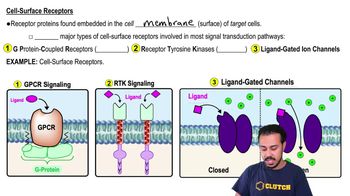Binding of a signaling molecule to which type of receptor leads directly to a change in the distribution of substances on opposite sides of the membrane? a. intracellular receptor b. G protein-coupled receptor c. phosphorylated receptor tyrosine kinase dimer d. ligand-gated ion channel
Consider this pathway: epinephrine → G protein-coupled receptor → G protein → adenylyl cyclase → cAMP. Identify the second messenger. a. cAMP b. G protein c. GTP d. adenylyl cyclase
 Verified step by step guidance
Verified step by step guidance
Verified video answer for a similar problem:
Key Concepts
Second Messengers

G Protein-Coupled Receptors (GPCRs)

Adenylyl Cyclase and cAMP

The activation of receptor tyrosine kinases is characterized by a. dimerization and phosphorylation. b. dimerization and IP3 binding. c. a phosphorylation cascade. d. GTP hydrolysis.
Lipid-soluble signaling molecules, such as aldosterone, cross the membranes of all cells but affect only target cells because a. only target cells retain the appropriate DNA segments. b. intracellular receptors are present only in target cells. c. only target cells have enzymes that break down aldosterone. d. only in target cells is aldosterone able to initiate the phosphorylation cascade that turns genes on.
Apoptosis involves all but which of the following? a. fragmentation of the DNA b. cell-signaling pathways c. lysis of the cell d. digestion of cellular contents by scavenger cells
Which observation suggested to Sutherland the involvement of a second messenger in epinephrine's effect on liver cells? a. Enzymatic activity was proportional to the amount of calcium added to a cell-free extract. b. Receptor studies indicated that epinephrine was a ligand. c. Glycogen breakdown was observed only when epinephrine was administered to intact cells. d. Glycogen breakdown was observed only when epinephrine and glycogen phosphorylase were mixed.
Protein phosphorylation is commonly involved with which of the following?
A. ligand binding by receptor tyrosine kinases.
B. activation of G protein-coupled receptors.
C. activation of protein kinase molecules.
D. release of Ca2+ from the ER lumen.
